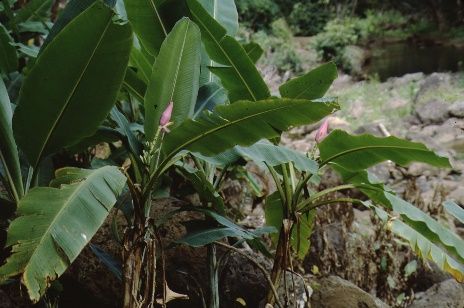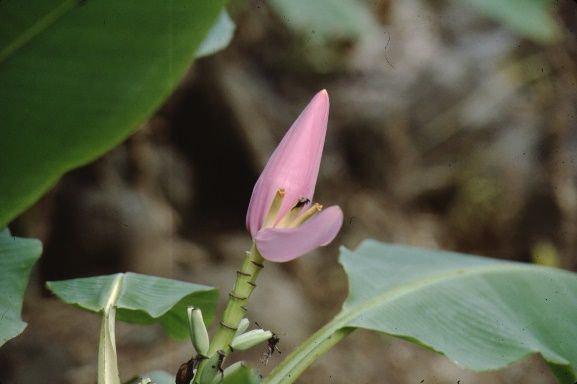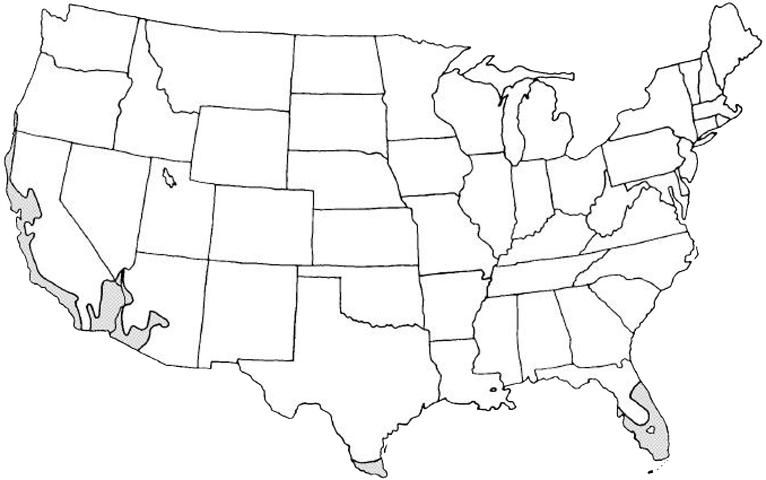Introduction
Musa rosa is a tall, herbaceous perennial that reaches a height of about 4 feet. This ornamental, stoloniferous plant has large, evergreen leaves that can grow to a length of about 3 feet, much smaller than the banana common in many Florida gardens. These leaves are pale green with dark green variegation, and they impart a coarse texture. The hanging orange and yellow flowers of this plant are borne terminally under protective bracts. They are covered by pinkish-red bracts and appear in the summer. Fruits hang in clusters and are quite edible.

Credit: Edward F. Gilman, UF/IFAS

Credit: Edward F. Gilman, UF/IFAS
General Information
Scientific name: Musa rosa
Pronunciation: MEW-suh ROE-zuh
Common name(s): banana
Family: Musaceae
Plant type: shrub
USDA hardiness zones: 9B through 11 (Figure 3)
Planting month for zone 9: year round
Planting month for zone 10 and 11: year round
Origin: not native to North America
Invasive potential: aggressive, spreading plant
Uses: specimen; accent
Availability: somewhat available, may have to go out of the region to find the plant

Credit:
Description
Height: 2 to 4 feet
Spread: 4 to 6 feet
Plant habit: palm
Plant density: open
Growth rate: fast
Texture: coarse
Foliage
Leaf arrangement: spiral
Leaf type: simple
Leaf margin: entire
Leaf shape: oblong
Leaf venation: pinnate
Leaf type and persistence: evergreen
Leaf blade length: more than 36 inches
Leaf color: green
Fall color: no fall color change
Fall characteristic: not showy
Flower
Flower color: orange; yellow
Flower characteristic: summer flowering
Fruit
Fruit shape: elongated
Fruit length: 6 to 12 inches
Fruit cover: fleshy
Fruit color: red; yellow
Fruit characteristic: suited for human consumption; persists on the plant
Trunk and Branches
Trunk/bark/branches: typically multi-trunked or clumping stems; showy
Current year stem/twig color: not applicable
Current year stem/twig thickness: not applicable
Culture
Light requirement: plant grows in part shade/part sun
Soil tolerances: extended flooding; acidic; slightly alkaline; sand; loam; clay
Soil salt tolerances: poor
Plant spacing: 36 to 60 inches
Other
Roots: sprouts from roots or lower trunk
Winter interest: no special winter interest
Outstanding plant: not particularly outstanding
Pest resistance: long-term health usually not affected by pests
Use and Management
Musa rosa imparts a tropical effect in any garden or landscape. It makes a charming specimen plant that can be planted among shrubs or by itself as a specimen in a small, protected garden. They will be frozen to the ground in central Florida during the winter months. Since the growing point remains at or slightly below the ground, plants grow back if winter temperatures remain above 20 degrees.
This plant needs to be installed in an area of the landscape that receives full sun to partial shade. It prefers moist, fertile soils, but adapts to about anything. It grows well in wet sites.
Musa rosa is commonly propagated by division of the matted clumps.
Pests and Diseases
Diseases of Musa rosa include cercospora leaf spot, Panama disease, scales, and nematodes.